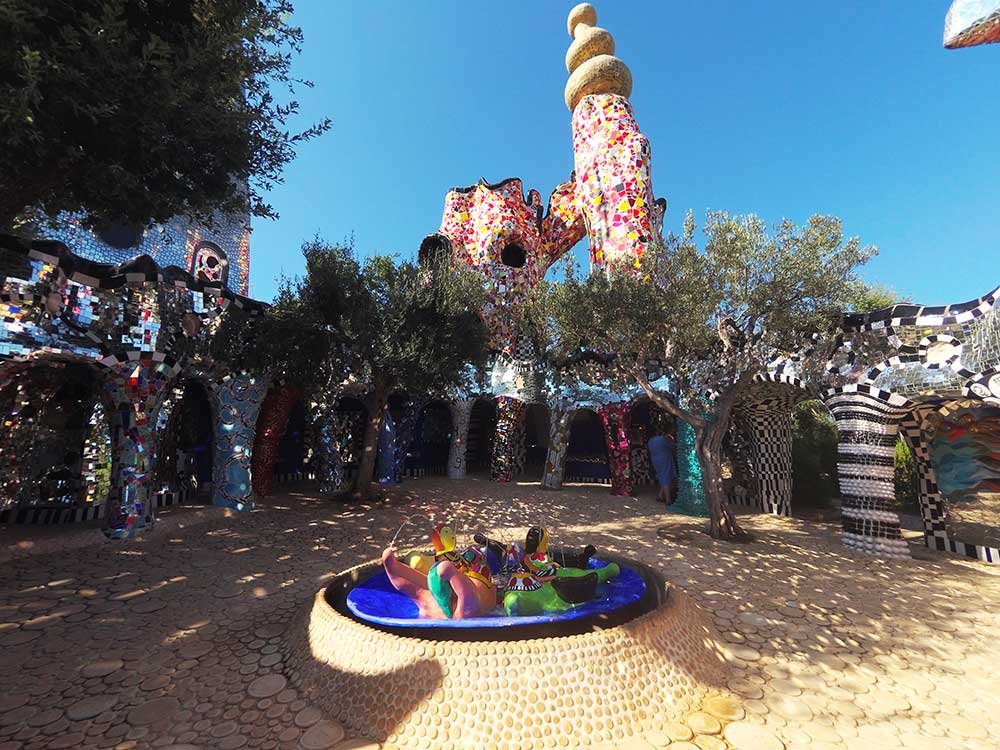Visiting the Tarot Garden of Niki de Saint Phalle is an experience that you will not forget.
I had long desired to go there but I did not really expect what I have seen. It was a journey in the eclectic mind and in the life of an artist that I knew very little and that fascinated me, pushing me to deepen.
The choice of not to explain her work and her sculptures is interesting. However, I decided to write in this post my subjective interpretation of her tarot representations.
Find all the practical information to discover this unique garden!
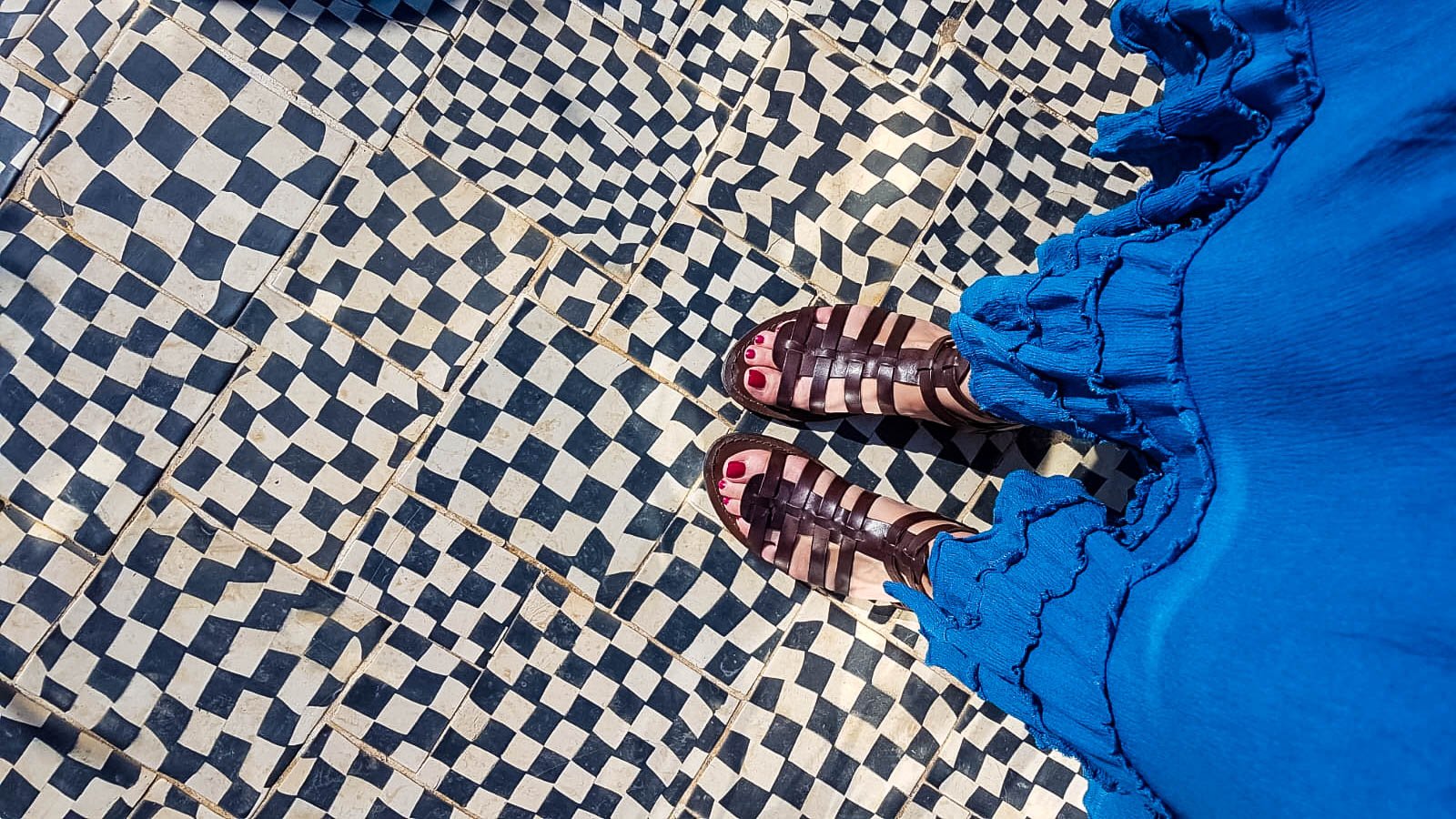
What are tarots?
Tarot cards are a deck of cards whose origin is still discussed. Surely they were already used in northern Italy around the fifteenth century. The cards are divided into minor and major arcana. Minors are the Italian cards that are still used in games that we all know as scopa, rubamazzo or trump. The major arcana, which we do not use today to play, have over time assumed a different value. They lost their role as playing cards to be considered instruments for predicting the future.
The major arcana are 21 with the addition of the Fool. These are figures of people or objects that represent concepts. In the interpretation of the cards, each has different meanings, which combined with the others, would help to elaborate the response on the choice to be taken. Different traditions have represented these figures in a different way and with different attributes but it must be kept in mind that in each of the representations every small object or decoration has a specific meaning. That’s why it’s so interesting to see how the artist Niki de Saint Phalle portrayed these characters!

The inspiration of Niki de Saint Phalle
The French-American artist was visibly inspired, as she wrote, both at the park of the monsters at Bomarzo and at Villa d’Este at Tivoli. But one of his most constant inspirations was the Spanish architect Gaudi.
In the construction of the Tarot garden in particular, it is clear that she was inspired by parque Guell in Barcelona.
The artist personally financed the project, which went on from 1979 to 2002, when she died. She gave indications on the openings, the preservation of her creations and to leave incomplete the works that she had not been able to finish. An incredible job that she carried on with her husband Jean Tinguely, who owes the numerous self-propelled mechanical structures, and a few other friends, artists and architects. In addition to numerous workers, there were:Nico Weber, Sepp Imhof, Paul Wiedmer, Dok van Winsen, Pierre Marie ed Isabelle Le Jeune, Alan Davie e Marino Karella.

Tarot garden: 21 (and more) incredible sculptures
Speaking of the major arcana of the tarots, have been and are still used as esoteric figures able to predict the future. It is no coincidence that Niki de Saint Phalle chose these figures and associated them with other concepts considered to be “esoteric”. As we said, everyone can see what he wants, and I saw a metaphor of life and an invitation to introspection. Visiting the Tarot Garden means making an initiatory journey in a more or less conscious way.
Tarot garden: Wheel of Fortune
It is not clear, as soon as you arrive, that even the large fountain at the entrance represents a card. It is the wheel of fortune, the 10th card. In the tarot reading, it can represent the change, the cyclicity, the passing of time. Luck comes and goes, it’s up to us to catch it. The big wheels, like a gear, are moved by water, which I have read as the representation of chance, of events, something that flows and can not be stopped, making the rest of the gears of existence spin. The four hearts on the big wheel seemed like a four-leaf clover, a symbol of good luck. Placed under the Magician and the High Priestess, this fountain takes on an even more deep significance.
Tarot garden: the Magician
The first sculpture that you meet when you go to visit the Tarot Garden is, almost inevitably, the Magician. Also called Bagatto or Alchemist is the first card of the major arcana. It is easy to identify because it is superimposed on that of the High Priestess and is represented as a face, a sort of mask, with a raised hand, entirely covered with mirrors. In the cards, the Magician represents the union of the divine with the ground but also creativity. The alchemist is the one who transforms the elements, which is the master of knowledge and puts it at the service of others: it is not what the artists do, and in particular Niki de Saint Phalle, giving us the opportunity to visit this garden?
Tarot garden: the High Priestess
The enormous sculpture immediately reminds one of the ogre in the garden of the monsters of Bomarzo. A huge gaping mouth, from which comes out the water that feeds the fountain, the hair in disarray. The Papessa, card number 2 represents duality, something secret that must not be revealed and is always designed as a seated priestess. Water is often linked to the figure of the moon, present in the card, and associated with the woman, perhaps for this reason Niki de Saint Phalle has associated it with this representation. It looks like the Caravaggio’s Medusa or the Medusa of the Capitoline Museums. Inside the High Priestess’ mouth we find the real priestess. In a starred cave in which the water creates incredible reverberations of light, there is a cloaked figure that seems almost alive. She is the real papessa, she who keeps unconscious and secret knowledge that can not be revealed.
Tarot garden: the Empress
It is impossible to visit the Tarot Garden and do not stare at the enormous structure of the Empress. The number 3 card of the major arcana is also built as the house where Niki de Saint Phalle lodged during the construction of the garden. The figure, covered with colorful ceramics, is easily assimilated to the Nanas represented in numerous installations by the artist. Prosperuous and huge, I do not think it is a case that she has been chosen as a home. Indeed, the Empress represents motherhood, fecundity and femininity. It is the one who gives life and thanks whom things come to life, the creative force. Inside there was the artist’s home, as if it wes the place where ideas and projects came to life. Incredibly, the house is all made of mirrors (I still wonder how they could clean that mosaic of mirrors!), I fall in love with it at first sight.
Tarot garden: Strenght
This was absolutely my favorite. A giant dragon of green mirrors, with fiery red wings, grinds his teeth in front of a woman dressed in white, one hand on her side, the other who seems to keep him on a leash. Force is the 11th card of the tarot, and usually the young woman dressed in white is portrayed with a horizontal 8, symbol of the infinite, in the act of opening the mouth to a lion. The interpretation given by Niki de Saint Phalle immediately made me think of a revisitation of the work of Paolo Uccello’s Saint George and the dragon. Here a young lady holds a huge dragon on a leash and seems to want to stop the knight who is piercing him. Strength, the real one, is to tame the most frightening of all beasts: ourselves. The true force is to be masters of themselves, of our own instincts, of our own destiny, of our own impulses. The white of the woman’s dress represents purity of mind and intent, which is needed to learn to be strong. In this interpretation the invisible leash that binds the two characters seems to be more than present.
I think that being so fascinated by this work means that I still have to work hard on myself before I get to the point of keeping my inner dragon on a leash. I have reflected a lot on this point. We will see!
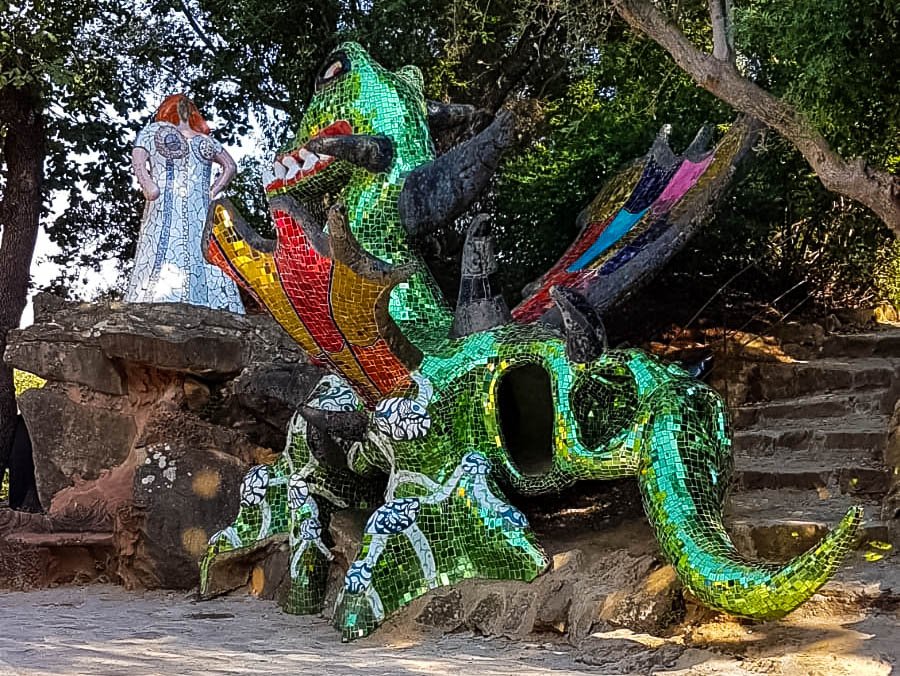
Tarot garden: the Sun
On the other side of the square there is a huge door with a representation of the Sun. Card number 19, the sun represents victory, successes and vital light. Niki de Saint Phalle wrote that she represented a bird because they are the closest living beings to the sun. But I interpreted it as if it was a phoenix, the legendary bird that is reborn from its ashes. To visit the tarot garden you will necessarily have to go through it. In the end, who more than the sun can symbolize the “resurrection” as rebirth, physical, emotional or spiritual?
Tarot garden: the Pope
In the tarot, the Pope represents spiritual knowledge. Here the artist interpreted him as a saint, a hermit, an enlightened person. Based on the structure on which he is kneeling, there is a face with the third eye opened, symbol of spiritual enlightenment. In the cards, the Pope is traditionally portrayed while teaching two monks, assuming the meaning of teacher or guide. Here there is a very colorful female figure who raises her gaze to the triple cross. The fact that it is the number 5 card of the tarot cards, also represents the quintessence or fifth element, the spiritual part that is difficult to explain.
Tarot garden: the Hanged Man
The hanging stands in a sort of niche of mirrors, the colours outlines and an evanescent body, hanging by a heel. The 12 tarot card represents a young man hanging upside down that seems calm and peaceful. In fact, this card combines the balance and the “alternative” point of view, the one that can have a person hanging upside down. It is one of the most enigmatic figures that you will see if you want to visit the tarot garden. He is interpreted as an anti-conformist, a person who lives his life regardless of the judgment of others and able to find, however, a balance.
Tarot gardent: the Hermit
Niki de Saint Phalle thought the hermit as an almost transparent statue. This man in search of his spirituality and the secrets of life, is represented with a stick that looks very much like a caduceus. It is the 9th card, and represents wisdom and inner research. The artist says that she thought the oracle as the female version of this card (which does not exist in traditional tarot cards). You will find the oracle sculpture later, climbing the hill.
Tarot garden: Justice
I really liked the interpretation of card number 8, justice. The artist conceived it as a huge woman dressed in black and white (good and evil), holding a weight scale, made up of her own breasts. In his huge skirt, there is a niche, closed by a gate, in which move the gears of a mechanism created by Niki’s husband, Jean Tinguely. This car shrieks and makes a horrible noise, between skulls of animals and strange gears that look rusty. When visiting the tarot garden, the first thing that came to my mind when looking at this statue, is that justice always contains a part of injustice, never being all black and white but of many different nuances. My travel companion instead saw it as a way of representing the rusty and complex mechanisms to get to justice, the years of trial, accusations and counter-accusations and so on. What is certain is that we are not speaking only of justice in a general sense, but above all of being just and capable of judging ourselves. As we have said, the “symbolic” reading of the tarot pushes the analysis of oneself first and foremost, and justice is what we must find with our behavior, every day.
Tarot garden: the Star
Conceived as a fountain, this statue is incomplete and offers an interesting opportunity to understand the process of creating sculptures. The edges of the tub are in fact free of colored majolica. The tarot card represents a young, naked woman pouring water from two jugs, one that feeds the rivers of the earth and another a lake or sea. It is the 17th card and when visiting the tarot garden, you will realize that it is one of the few that smiles. Symbolically it is associated with the flow of life and nature but also of time.
Tarot garden: the Lovers
The 6th card is that of the lovers that the artist has represented as Adam and Eve. It is the card of choice, a conscious choice. A young couple who is making a choice: right or wrong? Personally I find that the choice to renounce all pleasures, comforts, even the eternal life for the KNOWLEDGE, is not at all wrong. Obviously it is the hardest road but, as Dante said “Consider well the seed that gave you birth: you were not made to live as brutes, but to follow virtue and knowledge…” I thought about these words when I visited the Tarot Garden.

Tarot garden: the Emperor
You can not visit the Tarot Garden without dwelling on the emperor. Inserted in a visionary architecture made of two levels that open onto an internal court, the emperor is that big red and golden sculpture. The fourth tarot card represents Man, as male energy and power. It is superposed in a sort of cloister very similar to the architectures of Gaudì at Parque Guell, with a fountain in the center, mirrors, majolica and columns, chessboards and skulls reminding those of the Mexican dia dos muertos.
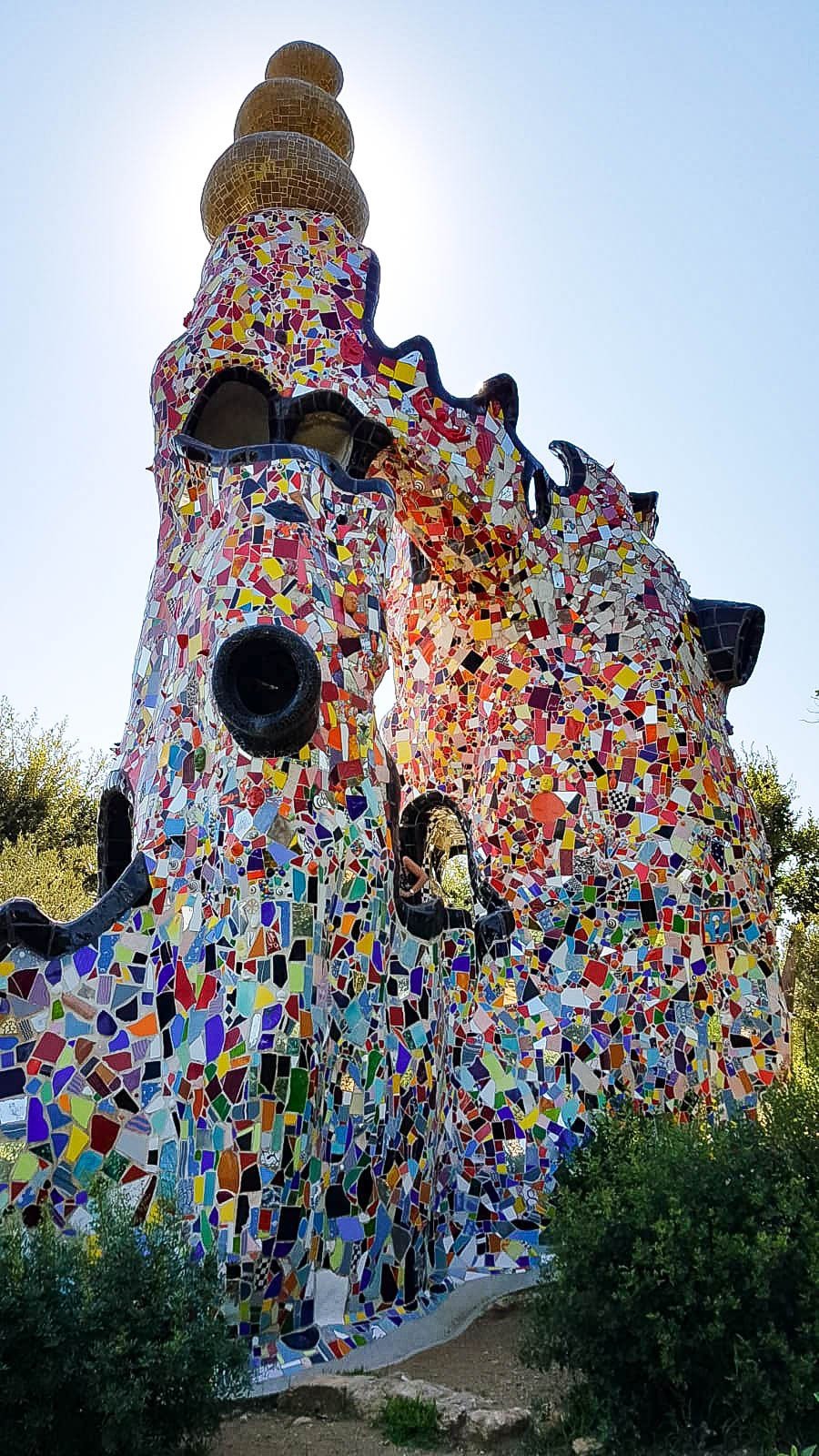
Tarot garden: the Tower
Not far away is the tower, 16th arcane. It represents the tower of Babel and, according to Niki de Saint Phalle herself, it is a physical and mental construction that must be demolished to look beyond. Above, the iron sculpture represents the lightning that strikes and destroys it. I thought it was a little representation of life: sometimes our certainties collapse but only to be rebuilt on a more solid basis. Its size is impressive and it really seems to fall on you!
Tarot garden: the Judgement
Within the chapel dominated by Temperance, there is a representation of the Judgment, not only as a universal judgment but also as life of the human being. It is in fact represented on a mirror, with three different figures that can be read as the three ages of man or three people of different ethnicities, African, Asian and European. These three men are all in front of a grave. The judgment is the arcane 20th of the tarot and reiterates the concept of equality: we are all equal in front of the death and the “superior” judgment.
Tarot garden: the Chariot
The chariot represents victory. It was designed by the artist as a small sculpture inside the empress house. The chariot of victory always reminds me of what was being led by the Roman generals returning from the war, acclaimed and praised by the people. Behind the generals, however, there was a servant who whispered “hominem te esse memento” or “remember that you are only a man“. Victory is a deceiver and one must learn to stay on the chariot without being carried away by him. A warning and a teaching not to be underestimated!
Tarot garden: Temperance
Conceived as a private chapel, temperance throws water between two pitchers. It represents calm, responsibility but also awareness and patience. The 14th card is associated with the recollection and introspection of religion: it is within ourselves, thanks to patience and contemplation that we will find peace. The walls of the chapel are covered with mirrors, yet another invitation to look inside themselves.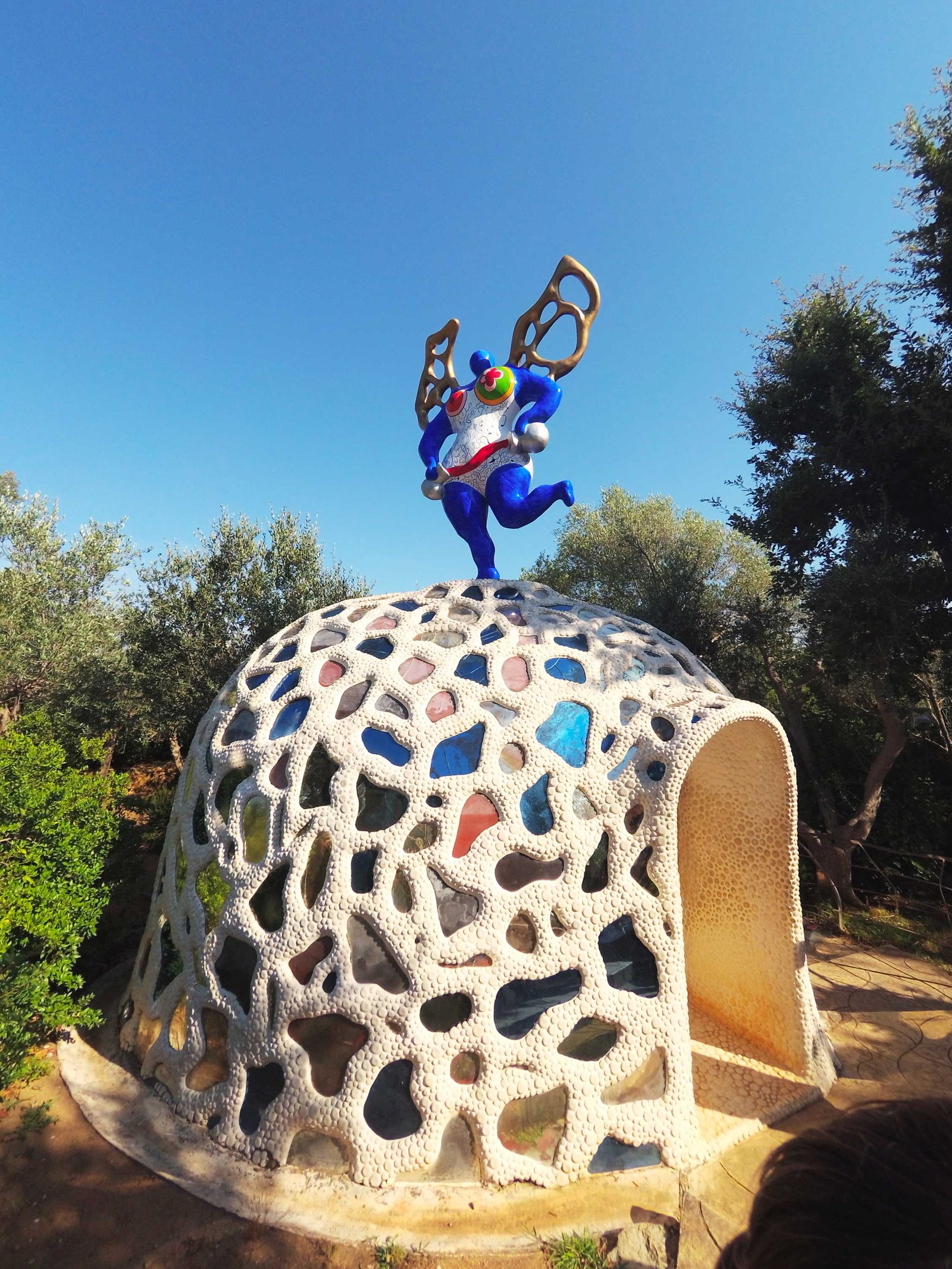
Tarot garden: the Moon
The sculpture of the moon was a little disappointing. This card, the 18th, is a clove from which emerges a female profile, supported by a sort of crab or lobster that resembles a little some Dalì’s works and that could represent cancer and at the same time the water, to which the moon is always tied . The meaning of the card is imagination, also understood in the sense of estrangement from reality. There are also two dogs underneath. I do not know, maybe I did not understand it well, it left me unsatisfied.
Tarot garden: Death
It is the 13th card that scares more but actually represents a profound change. Every day a part of us dies to make room for something new, it is true for ideas, for society and for generations. Death is a democratic equalizer also if it can appear ruthless. In the imagination of Niki de Saint Phalle, she rides a starry steed and mows everything, animals, plants and human beings. It is above everything and always on the move.
Tarot garden: the Devil
This sculpture is as disturbing as what it represents. It is linked to earthly pleasures such as sex but also to the use of drugs and loss of control. It is the opposite of the lovers’ card, the one in which a choice was proposed. Here the choice was clearly wrong.
Tarot garden: the Fool
Empty and full, colors out of place and a great dynamism characterize the card without the tarot deck number, the madman or fool. Represented as a traveler or a jester, the fool is one who has detached himself from all that is earthly and wanders in search of something higher and unreachable. It is not by chance that it is the card 0, or XXII, the principle or the final fulfillment. Or both?
Tarot garden: the World
The last sculpture you will encounter is also the last card, the XXI. The world represents life, creation, fulfillment. It is no coincidence that the artist represents him as an egg, symbol of life but also of perfection, surrounded by a snake that recalls the caduceus of medicine but above all the uroborus, symbol of infinity, the snake biting its tail. A mechanism rotates the sculpture that seems to ascend upwards. It is the end of an initiatory and interior journey that has left us this artist so visionary and original!
Other sculptures in the Tarot garden
From the oracle that looks like a Cretan goddess of snakes to the cat Ricardo, from the prophet of mirrors to the sculptures of gigantic snakes that tell us the story of the life of Niki de Saint Phalle as a modern serpentine column of Delphi, the garden does not end in the cards tarot and in the meanings that we can read. Even the entrance panel tells us about this artist’s project, her vision of life and art, as well as tarot and esotericism. The bonds that make up his sculptures / architecture, the path that winds through floors covered with phrases, signatures, poems, hieroglyphs and chessboards, is all part of an incredible and absolutely visionary project. One thing is certain: for me it was an inspiration and an incredible food for thought!
How to arrive to the Tarot garden
The garden is not very well marked but is not far from Capalbio, in Tuscany. It is located in Garavicchio, near Pescia Fiorentina. If you are wondering how to get to the Tarot Garden from Rome is simple: just take the E80 or Aurelia in a northerly direction. The motorway from Civitavecchia is the fastest way.
Tarot garden tickets and practical info
The price of tickets to enter the Tarot Garden is 12 euros for adults, 7 euros reduced. Find information on the opening hours, the period in which it can be visited and the reductions on the site of the Tarot Garden.
I’m not an expert on tarot and esotericism, so I think I understood only a tenth of the real meaning that the artist wanted to give to this park and its sculptures, but I assure you that they are beautiful even for those who do not understand anything (like me). If someone has been there I would like to know your impressions: did you like it? Did you already know this artist? What was your favorite sculpture / architecture? Let me know in the comments!




